#seishun 18 kippu
Explore tagged Tumblr posts
Text
Seishun 18 Ticket, Major Rule Revision. Railroads are not the only means of cheap travel! LCC, ferry, express bus, etc. ...... backstage way to think about it. Summary of nationwide "discount free tickets" that can be as low as 1,000 yen per day.
However, the 18-kippu ticket is not the only means of budget travel. Let us consider various “low-cost, long-distance travel methods” that are not limited to railroads. Since the Seishun 18 Ticket allows cheap travel at 2,410 yen per day, it has often been used for long-distance travel within the range of a regular train, and for sightseeing the next day. The ticket has often been used for…
0 notes
Note
1 3 5 18 21
Prefacing this by saying I'll probably say a bunch of songs for each cuz I'm crazy like that
A song you like with a color in the title
Shoutouts to The Red Means I Love You by Madds Buckley, gotta be one of my fav songs ever. Other Color Songs include White Happy by MARETU, Red Wine Supernova by Chappell Roan, and Yellow by Yoh Kamiyama
3. A song that reminds you of summertime
Gotta go w Seishun Kippu by MafuMafu here, maybe because it's the opening for Play it Cool, Guys! and that anime's ending is in a beach but it just feels like a vacation-y song, other songs include This December by Ricky Montgomery, Love Like You by Rebecca Sugar and the entire Encanto soundtrack
18. A song from the year you were born
Okay the only one I have is Pump It by the Black Eyed Peas. Most of the songs I like came out either a long time before or at least like a year after I was born lmao (was going to go for Adele for example but she started publishing in 2007)
21. A Favorite song with a person's name in the title
Unironically the best I got for this one is ASGORE by Toby Fox. There are others like Midna's Lament, Fergalicious and Fur Elise (as you can see there is a bit of diversity when it comes to the songs I like LMAO) but yeag
1 note
·
View note
Text
J'ai acheté le Seishun 18 kippu. Un équivalent de Interrail de 5 journées max définies sur les vacances scolaires japonaises.
Très heureuse de voir qu'avec seulement mon trajet d'aujourd'hui, mon ticket est remboursé quasi de moitié.
1 note
·
View note
Text
Sunawachi Sei (即ち性) - Katamichi no seishun [18 kin] kippu (片道の性春[18禁]切符) (сэмплы) / Релиз: 2019.7.6

Читать дальше »
1 note
·
View note
Text
Seishun 18 Kippu
Le "Seishun 18 Kippu" est également connu sous le nom de "Seishun Juuhachi Kippu". #japon #voyage #tourisme #culture #evasion #train #tohoku #kanto #kyushu #hokkaido #chubu #chugoku #shikoku #kansai #jr #jrpass
Le "Seishun 18 Kippu" est également connu sous le nom de "Seishun Juuhachi Kippu". Seishun signifie « jeunesse » et kippu fait référence au billet de train. Si ce billet s’adresse d’abord aux étudiants, il est accessible pour tout le monde sans restrictions d’âge, y compris pour les touristes étrangers. Achat Le billet coûte 11850 Yens et est valable pour 5 jours de trajet. Il est disponible…

View On WordPress
0 notes
Text
Average monthly expenses for one person 2020

Local buses in large cities like Tokyo and Osaka complement the train and subway networks, and are the main means of public transportation in cities with less dense train networks and in the suburbs. Basic Monthly Budget Housing and Utilities, 1,568, 24.8 Food, 773, 12.2 Child Care, 1,300, 20.5 Health Care, 522, 8.2 Transportation, 556, 8.8. Bicycle parking can be found near most railway stations and shopping centers. The estimated living cost for the US is around 10000 to 18000 per year, which averages around 1000 to 1500 per month. Check out our Guide to Japanese train tickets for more details.Ĭycling is a very cost-effective way of getting around especially if you live in the city. Discount rail passes available to foreigners living in Japan include the JR Tokyo Wide Pass and the JR Seishun 18 Kippu amongst a few others. While a large variety of other discount offers is available for train travel in Japan, residents in Japan cannot use many of the rail passes like the Japan Rail Pass. Many Japanese companies pay part or all of their employees' train commuting expenses. Gas water heaters and cooktops are common in most residences, though some modern homes may have induction cooktops instead.Ī large Uniqlo store Commuting and transportationĬommuters can purchase train commuter passes for unlimited travel between their home and office/school for one or multiple months. The average weekly childcare cost for one infant is 565 for a nanny, 215 for a. The average cost for utilities for one person is around 10,000 yen a month: about 5000 yen for electricity, 3000 yen for gas and 2000 yen for water. Learn what you can expect to spend each month when raising a child. The Cost of Living Study provides a yearly estimate of the basic-needs cost of living in Minnesota, for individuals and families, by county, region. The average cost in Paris for monthly maintenance charges is 25 (29.75) per square meter. 2020: 2019-2020: 2012 forward: 2011-2012 forward: MY: Errata for 2019: Occupation of reference person. Utility costs will also depend on the size of your property. Hispanic or Latino origin of reference person. Electricity is usually the most expensive of the three followed by gas and water. 2020: 2019-2020: 2012 forward: 2011-2012 forward: MY: Errata for 2019: Additional demographics. Not usually included in the rent are utilities, such as electricity, gas and water, except at some gaijin houses and monthly rentals like Leopalace. Gaijin houses, on the other hand, are inexpensive and relatively hassle-free options to consider for those who want to stay in the city and prefer not to rent conventional apartments. Rent for similarly sized apartments in central Tokyo and popular neighbourhoods nearby usually start from around 100,000 yen. The nationwide average monthly rent, not including utilities, for a one room apartment (20-40 square meters) is between 50,000 and 70,000 yen. Outside of central Tokyo, housing costs are distinctly lower, especially in the suburbs, surrounding prefectures and in other regions and cities of Japan. However, rent can vary from cheap tiny apartments of around 10 square meters to exorbitantly priced luxury apartments in prime districts. Some of the world's most expensive land can be found in central Tokyo, which contributes to its reputation of being an expensive city.

0 notes
Text
New Years in Japan: A Niigata Family Gathering to Celebrate the New Year
It’s that time of the year again. The New Year is awaiting us, and with it, one of the most traditional seasons in Japan is around the corner. Because what Christmas is for us in Europe and the US when the whole family gathers, is what New Year celebrations are in Japan. But what kind of traditions and customs exist in Japan during New Year’s (お正月, oshōgatsu) and how do they differ from family to family?
I was lucky enough to spend the New Year’s holidays with my boyfriend’s family in Niigata Prefecture and to personally experience the traditions and customs of the holiday. And of course, I want to share these experiences with all of you.
This post contains links. Thank you so much for your support and for helping keep this blog running!
A Deep Clean to Start to the New Year in Japan
Since we had planned to go to Niigata on December 30th, more precisely to Nagaoka, our preparations for the New Year began a few days in advance.
A typical part of the New Year’s traditions is the so-called osōji (大掃除), the big clean-up before the turn of the year. Old, forgotten items are sorted out, and every corner of the house gets scrubbed clean. A house or apartment can look more like a battlefield during this cleansing to purify a room from dirt and dust collected from the old year.
Travelling the New Year’s Rush in Japan
If you plan to spend the New Year in Japan, you should be warned that, as the Golden Week holiday in spring, New Year’s is one of the most popular travel seasons, and trains will be crowded.
Since the Shinkansen was too expensive for us, we started the journey from Tokyo to Nagaoka with the local train lines on Seishun 18 Kippu. So, a normal 2-hour Shinkansen ride became a 5 ½ hours, most of which we had to stand as we weren’t the only ones who wanted to visit their families.
Of course, there are also cheaper options for train travel in Japan. For example, you can find more information about the Japan Rail Pass in our article about transportation in Japan.
Read more: https://cupdf.com/document/new-year-in-japan.html
You will have to get used to a fully booked Shinkansen and overcrowded local trains at this time. Convenience stores and ATMs in more rural areas may also be closed.
New Year Tradition of Cards and Decoration in Japan
Another integral part of the Japanese New Year is the nengajō (年賀状) New Year cards, which typically depict the zodiac animal of the coming year. The zodiac sign for 2020 is the rat, and 2021 will be the year of the Ox. Most of the pictures and decorations resembled cute mice, and we opted for small hamster-like rodents for our New Year’s cards.
While we were taking care of the nengajō, my boyfriend’s father prepared the kagami-mochi (鏡 餅, “mirror rice cake”), which is placed in front of the kamidana (神棚), a miniature Shinto household altar. The kagami-mochi consists of two stacked rice cakes, which are rounded off by a mandarin (みかん, mikan) on the top. It represents a typical symbol of New Year in Japan.
Read more: https://cupdf.com/document/new-year-in-japan.html
These mochi rice cakes may not be eaten until January 11th, as they embody the god Toshigama-sama and is only appropriate to eat once the god has left the household.
Osechi Ryori: New Year Dinner in Japan
Thankfully, waiting to eat the mochi was not a big deal, as the highlight of that December 31st evening was the osechi-ryōri (お節料理). This traditional Japanese New Year food is a true feast for both eyes and stomach. The components of the osechi, as it is abbreviated, are often prepared with a lot of sugar, mirin and soy sauce to make them last longer. There’s usually so much food in an osechi meal that you can eat leftovers for the next few days after the New Year.
Read more: https://cupdf.com/document/new-year-in-japan.html
In addition to the traditional osechi, my boyfriend’s mother served us sushi, crab and various salads. As she explained to me, osechi dished differs from family to family. Local specialties dominate most of the dishes. Due to its proximity to the coast, Nagaoka has a variety of delicious seafood to offer, so it wasn’t surprising that these were generously available that evening.
New Year Games and Special TV Programs for Family
While we in Germany or other Western countries may go out for a New Year’s Eve party, New Year’s Eve in Japan is a cozy event that is spent at home with family. An integral part of the night also includes watching the numerous New Year specials on the television.
Read more: https://cupdf.com/document/new-year-in-japan.html
For my boyfriend’s family, hanafuda (花札) is a part of a typical New Year’s tradition. The “flower cards” symbolize the year’s 12 months and each card has a different value. We were so absorbed in our game that we almost missed the countdown that appeared on the TV that was playing in the background.
Midnight Tradition in the New Year with Toshikoshi Soba Noodles
By now, we would have opened the champagne bottles in Germany and hugged each other, but the transition to the New Year is a bit calmer in Japan.
With an “Akemashite omedetō!” (明けましておめでとう), we wished each other a Happy New Year before the culinary feast continued with toshikoshi soba (年 蕎麦し蕎麦) shortly after midnight.
Soba, or buckwheat noodles, that are an integral part of Japanese cuisine. On New Year, toshikoshi soba symbolize the transition from the old year to the new year, just as biting off the buckwheat noodles is equated with letting go of the old year.
Read more: https://cupdf.com/document/new-year-in-japan.html
We ate them in a cold dashi broth with spring onions and some spices and sesame, but there can also be different variations, depending on the taste of the person or family.
Hatsumode: Bringing in the New Year with a Prayer
After eating toshikoshi soba, the New Year festivities continued. We put on our thick winter clothes and headed to a small shrine in the neighborhood, called the Hachimangu Shrine, for our first shrine visit of the year called hatsumode (初詣).
Next, we headed to the next shrine of Hōtokusan Inari Taisha Shrine. It is said that it was built in honor of the sun goddess Amaterasu by order of the Japanese queen priest, Himiko, who lived from around 170 to 248.
Read more: https://cupdf.com/document/new-year-in-japan.html
At the Hōtokusan Inari Taisha Shrine, we wrote our names on small paper figures called hitogata. The white paper figures symbolize a man, and the red one, a woman. In addition to our names, we also wrote down our year of birth and current age.
We then handed them over to the shrine staff, and as my boyfriend’s father explained to me, these paper figures would later be burned while the priests prayed for our health and happiness. All bad luck would be removed from us by burning the hitogata.
The New Year’s Breakfast with Ozoni and Mochi
On January 1st, the obligatory New Year’s Sale will start. Before we plunged into the crowds, the traditional New Year’s breakfast was due. And, to my great joy, it consisted of a lot of mochi!
On January 1st, the sticky rice cakes are typically eaten in a savory or a sweet way, although it is not that easy to decide which variant you’ll prefer. Also, I wanted to try the traditional New Year’s soup ozoni (お雑煮). This vegetable soup, which is prepared with dashi, contains mochi as a special side dish.
Read more: https://cupdf.com/document/new-year-in-japan.html
In addition to the ozoni, we also had mochi with ankō (餡子), sweet red beans paste, as well as with kinako (きな粉), a powder made of roasted soybeans. This New Year’s tradition should be eaten with caution, as reports of deaths in which people have suffocated while eating the mochi increase every year. Therefore, you should not eat them too hastily and always have tea or water by your side!
New Year Shopping and Fukubukuro in Japan
After breakfast, we went straight into the hustle and bustle of a shopping mall, where shops lured customers in with sales that pop up around the New Year. The so-called fukubukuro (福袋, “lucky bags”) are particularly popular and contain goods from a specific shop, although you won’t know what’s in your bag until you purchase one. If you want to get a fukubukuro from a popular store like Pokemon Center or Ghibli, you should go to the store before the store opens as crowds can form quickly.
Our main destination was the grocery stores to shop for the arrival of more family relatives to visit that evening. That being said, it didn’t stop me from adding a few additional items like clothes into my shopping bag.
Read more: https://cupdf.com/document/new-year-in-japan.html
The Unique New Year Traditions of Each Family
The traditions vary from family to family, which is why I can only speak of my personal experiences. A tradition in my boyfriend’s family is to write your personal New Year wish to accompany you throughout the year. For the first time, I tried calligraphy during my New Year experience in Japan.
Otoshidama: A New Year Gift of Money
Another common tradition is to distribute otoshidama (年玉). This New Year’s tradition is especially joyful for the children as they receive money from the family’s adults. It is customary for the youngest to receive their pocket money at my boyfriend’s family before being handed out to the older children. As the oldest, I was the last to receive my otoshidama.
Afterwards, we played bingo to bet some of our small sums of New Year money, which was very entertaining for 13 people.
Experience a Different Kind of New Year in Japan
In case you ever get the opportunity to experience the New Year celebrations with a Japanese family, take advantage of this opportunity! It was a very special experience for me to experience all the traditions and customs first hand. Therefore, I would like to take this opportunity to thank my boyfriend’s family again — for the hospitality, the patience to explain everything to me and the warm welcome to their family.
Read more: https://cupdf.com/document/new-year-in-japan.html
0 notes
Text
Travel 2 - Hiroshima
Di Jepang ada alternatif liburan murah buat para mahasiswa yang ekonomis dan butuh hiburan. Salah satunya seishun 18 kippu yang ada setiap musim semi, panas, dan dingin. Tiket kereta murah ini bisa digunakan untuk traveling ke segala penjuru jepang dengan biaya 2370 yen per hari atau per tiket. Untuk keterangan lebih lengkap, baca di sini yaa: http://www.japan-guide.com/e/e2362.html
Nah karena aku adalah mahasiswa yang ekonomis dan butuh hiburan, aku berangkat ke Hiroshima tanggal 26-27 Agustus 2017. Sebenernya udah lama banget pengen ke sana, pernah sampai pesen tiket bus tapi harus dibatalin karena kerjaan lab. Makanya waktu tau ada festival kembang api di Miyajima, salah satu main attractions di Hiroshima, langsunglah aku cari penginapan di airbnb. Karena teman sepermainan lagi pada liburan ke Indonesia, jadinya aku berangkat sendiri.
Singkat cerita aku berangkat dari rumah dengan bus pertama ke stasiun JR terdekat. Total perjalanan dari rumah sampai Hiroshima sekitar 6 jam. Sesampainya di Hiroshima, aku langsung ke penginapan yang letaknya gak jauh dari Miyajima. Nama penginapannya Nara dan pemiliknya Kumi san. Begitu sampai, rasanya homy banget karena memang bentuk penginapannya itu rumah orang Jepang yang pemiliknya tinggal bareng dengan tamunya. Ternyata, ada beberapa tipe ruangan yang disewain: 1 ruangan besar buat 6 orang wanita dan mungkin 2 ruangan lainnya untuk keluarga.
Setelah beres-beres bawang bawaan, aku langsung menuju Miyajima menggunakan kapal ferry. Saat sampai di Miyajima, sudah banyak turis yang antusias ingin menyaksikan salah satu festival kembang api termegah di Jepang. Beruntungnya, aku ke sana sewaktu fase bulan baru, jadi di sore hari, air laut surut sampai pengunjung bisa menyentuh O-Torii, gerbang besar berwana oranye di Miyajima. Aku menghabiskan sunset di sana sambil duduk-duduk di spot tempat menonton kembang api, dekat dengan O-Torii.

O-Torii & sunset: perfect combo!
Sekitar pukul setengah 8 malam, panitia mulai bercerita tentang tema kembang api tahun ini. Aku sendiri gak ngerti karena bahasa Jepang yang digunakan gak lazim jadi yang aku lakukan adalah mengatur kamera dan speknya. Akhirnya setelah introduction yang panjang, festival kembang api dibuka dengan letusan pertama di belakang O-Torii. Kemudian menyusul kembang api berukuran jumbo di sisi kanan dan kirinya, sesuai dengan irama lagu yang mengiringi.
Karena keasyikan foto-foto, aku gak sadar kalau ternyata air laut mulai pasang dan sudah hampir menggenangi sepatuku. Makin lama air laut makin tinggi, memaksa para penonton mundur perlahan di sela-sela break kembang api. Terlepas dari kericuhan ini, festival kembang api di Miyajima adalah yang terbaik yang pernah aku saksikan selama 2 tahun tinggal di Jepang.
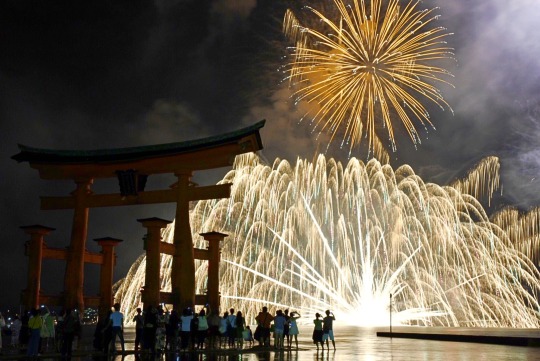
Festival kembang api Miyajima
Seperti yang sudah diduga sebelumnya, perjalanan pulang adalah yang paling merepotkan karena antrean ribuan manusia untuk menyebrang dari Miyajima. Perlu 1 jam hingga aku sampai di penginapan dengan kaus kaki basah, badan penuh keringat, dan perut kosong. Hal favorit lainnya dari penginapan ini adalah tamu bisa masak karena ada dapur dan peralatan masak lengkap. Hari pertama di Hiroshima ditutup dengan perut kenyang berisi mie instan indo***.
Di hari kedua, aku berangkat jam 6 pagi menuju pusat Hiroshima. Kereta tram di Hiroshima itu super cute dan aku berasa lagi di negara Eropa. Aku berhenti di Atomic Bomb Dome, berkeliling di Hiroshima Peace Memorial Park, dan mengunjungi museumnya. Kalau teman-teman ada kesempatan berkunjung ke museum ini, jangan lewatkan video testimoni dari saksi mata peristiwa bom atom Hiroshima. Seketika itu juga, teman-teman pasti akan merasa sedih, apalagi setelah melihat foto-foto korban. Aku bersyukur bisa melihat langsung kota yang sewaktu sekolah dulu selalu disebut guru saat materi kemerdekaan Indonesia. Perjalanan ini jadi perjalanan yang berkesan dan akan aku ceritakan ke anak cucuku nanti.

Hiroshima Atomic Bomb Dome

Hiroshima Peace Memorial Museum

Hiroshima Castle
7 notes
·
View notes
Text
Why was the announcement of the release of the Seishun 18 Ticket later than usual? We asked JR East.
I was worried that the Seishun 18 Ticket might not go on sale. A few days of anxiety The late announcement of the “Seishun 18 Ticket” release date has been attracting attention. Although it is clear that the release of the 18-kippu tickets had already been decided, as posters and other materials were released at the same time (this year) when the release date was announced, long-time 18-kippu…
0 notes
Text
little updates
(edited 2.19.18 to add photos!)
back in january, M and T finally had time to visit me down here in Shonan. felt really happy showing them around Enoshima–it was such a bright, clear day that I had the clearest view of Mt. Fuji I think I’d ever seen from Enoshima. unfortunately it was also incredibly windy and we probably spent our whole day squinting.

got the chance to introduce Chinese New Year to a few of my special needs classes! I’ve been wanting to talk more about Taiwanese culture during my time here, so I’m really happy the teachers were also willing.
finally plucked up the courage to call and order a new spare apartment key. had to pay a ridiculous 4000 yen for it, but better to have it than not.
observed elementary school English classes! grateful for the opportunity to do it, since we literally never get to go seeing as we’re SHS and SEN school ALTs. it was sad to think about the fact that those cute, excited kids shouting out all the English they knew would soon become the sullen, English-hating JHS students that most ALTs have to deal with…
A came to visit, and we filmed a ridiculous PR video with the governor to promote our prefecture, lol. #JETProgrammeexperiences
traveled to Kanazawa with M and family. ate gold for the first time, consumed a ton of delicious fish, and fell in love with the old samurai district.


went to the After JET Conference where I saw some familiar faces and somehow made some new friends. the fact that I’m going home soon started to feel real. the conference wasn’t all that special, and the career fair was mostly an awkward sort of experience, but going there felt good in the sense that it was one of the last JET-associated things that I would get to go to, and to be among those who had all been on the same sort of journey in this country was comforting.
had my wallet stolen in a packed train. so much for super-safe Japan!! I was in a right panic for two days until I found it again (without all the money but everything else intact), but then I was annoyed because I had to wait for my new bank card to arrive after voiding my old one in a panic. cue a week of exchanging my random bits of foreign currency and embarrassingly borrowing some cash from teacher friends to get by.
went to my favorite high school’s graduation. with my infrequent visits to schools, I had my doubts that I would ever be able to see this kind of ceremony, so I’m so glad it somehow all worked out. got to see some of my favorite students graduate and wish them well. incredibly proud that some will be studying in universities abroad!

embarked on the craziest 10-day solo trip across Western Japan in which I hit up Hiroshima, Miyajima, Shimane, Yamaguchi, Fukuoka, Nagasaki, and Okayama using only the Seishun 18 Kippu and a night bus. missed multiple local trains and lost a day bc I missed my initial night bus, but it turned out to be one of the best adventures I’ve ever taken. traveling by train is definitely the best way to travel, hands down. although it took a long time coming all the way back to kanagawa (literally a full day of sitting on trains), it was actually really pleasant and seemed to go by faster than I expected. journaling and reading definitely helped.


APRIL STAFF CHANGES. our beloved W-sensei, S-sensei, and Y-kachou sadly left the center, but we got 4 new English-speaking staff to replace them, and they’re all lovely people. but because they’re so lovely, it just makes it that much harder to leave them all so soon, after we just met.
tried to do a hanami but that had to be canceled bc of horrible rain and wind. instead we ate at a restaurant and rescheduled for a picnic in Yoyogi Park the following weekend. my cherry blossom appreciation time this year was sadly limited to just the blossoms outside my office (although granted, they were quite gorgeous). when will I ever get the chance to have an actual hanami party??
managed to watch Yabusame in Kamakura! unfortunately the crowds were insane and we couldn’t actually see them hitting the targets, but it was still cool to experience.


ate high-grade sushi at Kyubey for the first time as a birthday treat. learned to appreciate fresh uni.

officially registered to take the JLPT N2 in July. RIP me.
mom came to visit! the week didn’t quite go as smoothly and peacefully as I had imagined in my head, since I had my own idea of what would be fun and interesting, and she apparently had her own. I was a little let down that she didn’t seem as enthusiastic about being here as I expected (but it was probably just that she didn’t really know how to show it). I realized I must have really aged though because that whole week was exhausting, when usually I’d be fine (see: 10 day crazy spring break trip).
2 notes
·
View notes
Photo










Mellan 21-31 mars åkte jag och Luis på en resa mes seishun-18-kippu, en billig tågbiljett som ger unlimited snigeltåg i fem dagar för cirka 900 kronor. Rätt billigt eftersom man kan ta sig hela vägen från Tokyo till Beppu (halva Japan) om man så vill. Vi var en dag i Kyoto och tursitade en massor. Åkte buss till Luis favorittempel fullt med stenmänniskor. Var på ett berg med vilda apor, tittade på tempel och hälsade också på en Australiensisk vän till Luis som jobbar ensam på ett kafé. Det sista vi gjorde innan vi åkte vidare till Osaka var att klättra hela vägen uppför trapporna i Fushimi Inari Jinja, den kanske mest berömda shintohelgedomen i hela Japan. Det var ganska magiskt, speciellt i mörkret och eftersom inte så hemskt mycket turister orkar hela vägen upp. Det var fullt med katter! Vi sov i ett litet hål på ett hotell med tillsynes en i personalen, inget tvål på toan och endast två duschar för alla gäster. Speciell upplevelse men främst var det billigt. Hade en jättehemsk dag på Universal Studios! Vi var där i god tid innan öppning men fick ändå köa som tusan, och vi sprang bokstavligen till Harry Potter-delen där vi inte behövde köa speciellt mycket, tog massa bilder på slottet, drack Butterbeer och faktiskt trivdes, troligtvis mycket beroende på att de har en limit på hur många som får komma in samtidigt..! Tråkigt nog var alltid extremt dyrt så jag köpte ingen souvenir, men det var roligt att äntligen åka dit! När vi lämnade Harry Potter-delen såg vi att det var otroliga 4 TIMMARS KÖ på praktiskt taget alla åkturer. Oturligt nog hade alla Japans studenter lov samtidigt som jag så alla vallfärdade dit och sabbade för oss. Vi klagade en massa och Luis nästan svimmade när han insåg att de inte längre har gratis "fast-pass" som man kan hämta upp och "boka" tid på de populära attraktionerna. De hade det förut, men nu har de gjort om så man måste köpa, som i USA, ett speciallpass för hela dagen som kostar 15,000 ¥ plus vanligt inträde för 7,000! Man måste alltså betala cirka tvåtusen kronor för att kunna åka alls... Vi väntade i en timme för att kolla på en show, och sen en timme till för en annan men sen gav vi upp. Det är ju meningslöst att köa i fyra timmar, extremt tidsslöseri. Folk köade i slingor bara för att köpa popcorn!! Extremt dyra popcorn..! Vi gick kring tretiden. For in till Osaka och åt kushiyaki, takoyaki och lite annat på olika barer som vi hoppade mellan. Vi åt såklart inte på Universal Studios pga de extrema priserna, så vi åt ganska mycket trots att vi skulle träffa Luis vän Ryo och äta Okonomiyaki till middag, Osakas specialitet. Ryo är jättetrevlig och alla mat vi åt var väldigt god, så jag kommer aldrig rekommendera någon att åka till USJ, det är bättre att turista i det riktigt Osaka. Mycket mera prisvärt!! Dagen efter åkte vi förbi Himeji och kollade på deras slott. Det är det enda som finns där men det är ett bra slott som man kunde klättra hela vägen upp i. Fortsatte och på eftermiddagen kom vi till Kinosaki-onsen, kanske bästa stället på resan. Hade ett rum på ett ryoukan, och på kvällen gick vi till totalt sex (6!) olika onsens. Efter tre bad tog vi en paus och gick i våra starwars-yukata och åt middag, och sen gick vi till tre till. På kvällen lyste rosa lanternor upp floden som rinner genom den lilla byn och det var hemskt coolt! Alla går runt i yukata och dricker öl och det kändes som taget ur en film. Vi gick säkert en kilometer till den sista onsen, i japanska träskor med två klackar onödigt nära mitten vilket är riktigt obekvämt och vingligt. Efter 6 bad var det inte så skönt längre, sved liksom och man kände att kroppen var trött på varmvatten. Vi ville bara se alla bad och var ganska nöjda när vi kunde promenera hem! Det coolaste baden var ett täckt med stenar och ett konstgjort grottak, och sen ett bad med ett stort vattenfall som rann ner framför ögonen på en medan man satt i vattnet och kollade ut mot buskarna. Nästa dag åkte vi aslångt till Hiroshima. Anlände på kvällen hos ett slags Airbnb, ett hus i japansk stil en bit utanför staden och sov nästan direkt. Nästa dag var vi turister i Hiroshima, först åkte vi båt ut till Miyajima och klappade rådjur, tog foton med den berömda toriin i vattnet och såg en parad med dansande folk och monster och sånt. Väldigt avslappnat ställe, och vi hade tur med vädret också. Kollade in slottet som tyvärr behövts renoveras rejält så endast utsidan fortfarande ser äkta ut, insidan är ett vanligt museum. Promenerade i fredsparken och åt Okonomiyaki, Hiroshimastyle. Tog buss hem och tittade på originalversionen av ninja warrior och drack varsin öl sittandes under kotatsun i vardagsrummet. Jag råkade ta sönder pappersväggen när jag skulle öppna dörren. Först fick vi panik sen skrattade vi väldigt mycket. Pappersdörrar är en asdålig idé. Nästa dag var det mest tåg igen och vi mötte Takuya i Fukuoka på ryoukan-rummet. Vi promenerade igenom Fukuoka och åt middag och satt sen på en hemskt dyr och liten make-shift-bar (ett skul på 8 kvadrat) på strandpromenaden ovanför en flod. Jag var dödstrött nästa dag men vi använde tiden ändå till fullo och efter frukost på ett old style Mugiwaraboushi-liknande kafé åkte vi till Fukuoka tower (de har världens hemskaste temasång, usch, asjobbig, googla). Sen åkte vi tåg till en gammal stadsdel med mycket tempel. Det var riktigt vackert, speciellt när vi klättrade upp på det lilla berget, bort från turisterna. Vi klättrade genom en skog och kom till en tunnel av toriis liknande dem i Kyoto. Plötsligt ljöd musiken som spelas över hela japan klockan fem (lång historia) och det var riktigt magiskt att stå och lyssna till det ute i skogen. Lite högre upp bakom templet på toppen hittade jag en grotta det fanns ljus och fler rävfigurer att be till. Vi hade ett litet äventyr ute i skogen helt enkelt! Sista dagarna spenderade vi i onsenstaden Beppu. Näst sista dagen på resan kunde vi tack vare någon kampanj bada gratis på det dyraste badet, uppe på en höjd. Det bestod av flera små bad utomhus i varierande temperatur med utsikt över staden och mot havet. Fanns en bastu också och det var inte speciellt mycket folk. Klinkers istället för stenar är inte så mysigt men det var lite roligt att det regnade hela tiden, och att man slapp sitta nära andra människor. På det andra badet vi besökte blev jag attackerad av en jättefet gammal tant som började visa mig hur man skulle tvätta sig (?!?) vilket var motbjudande och störigt eftersom jag knappt förstod vad hon sa eftersom hon pratade på dialekt. Efteråt pratade tanterna om utlänningar (de trodde nog inte jag hörde) och jag skyndade mig ut och när jag berättade för Takuya och Luis om vad som hänt kom den smällfeta kärringen ut igen och började prata med Takuya om att hon behövt förklara saker för mig, fast att det var svårt för henne eftersom jag inte verkade fatta... Vi flydde. Asirriterande, låt folk vara..! Sista dagen åkte vi med en liten buss över en kam ner till en dal på andra sidan av ett berg. Hamnade i en jättefin liten by som vi promenerade bort ifrån i en cirkel och sen kom tillbaka till. Längst vägen fanns ett antal bad. Det var varmt och soligt så inte helt nödvändigt, och eftersom jag var lite trött på hetvatten räckde det med ett bad. Men vi hade en avslappnande sista dag tack vare naturen med skog och vatten, utsikt över berg, tempel och sånt. Somnade nästan på väg till flygplatsen och det var så sjukt skönt att komma hem!!
3 notes
·
View notes
Text
Pergi ke Jepang Berombongan? Yuk Beli Seishun 18 Kippu!
Pergi ke Jepang Berombongan? Yuk Beli Seishun 18 Kippu!

Spesial bagi minasan yang mengaku sebagai traveler berjiwa muda, yuk manfaatkan sebuah tiket musiman bernama Seishun 18 Kippu. Seishun 18 Kippu atau dalam bahasa Inggris Youthful 18 Ticket merupakan unlimited ticket yang dapat digunakan selama 5 hari. Kita dapat naik kereta lokal dan rapid train (bukan shinkansen) milik Japan Railways di seluruh Jepang.
Selintas, tiket ini memang mirip dengan…
View On WordPress
0 notes
Text
Téli vonatozás I. - Aizu
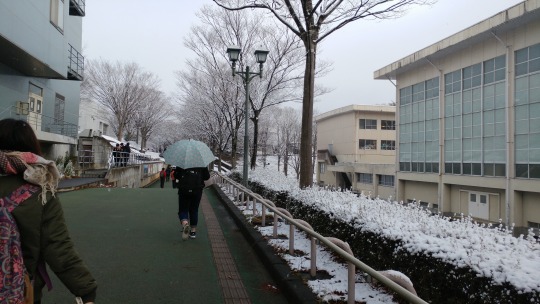
December közepére lehűlt az idő, elő kellett vennem a téli pizsamámat. Keddre kisebb adag hó is esett, így most először rendesen fehérbe borult az egyetem környéke. A nap azonban olyan erősen sütött, a városban délután már alig volt hó, így gond nélkül elbiciklizhettem az egyik használtcikk kereskedésbe. Kabátot akartam venni, mert már gőzerővel tervezgetjük a karácsonytól újévig tartó utazásunkat Yokohamába és Tokióba, az előrejelzés pedig azt mutatja, hogy akkor ott nappal 10 fok körül mozog majd a hőmérséklet. Ehhez a télikabátom meleg, a ballonkabátom pedig kevés, úgyhogy beszereztem egy jó állapotú fekete szövetkabátot. Ezen kívül találtam még két megfelelő árú kisméretű bőröndöt is, amikre lecsaptunk, hiszen jól jöhet még utazás során - mindketten csak a nagy bőröndjeinket hoztuk.
Közben befejeztem életem első pár (ujjatlan) kesztyűjét, úgyhogy már van egy szettem:
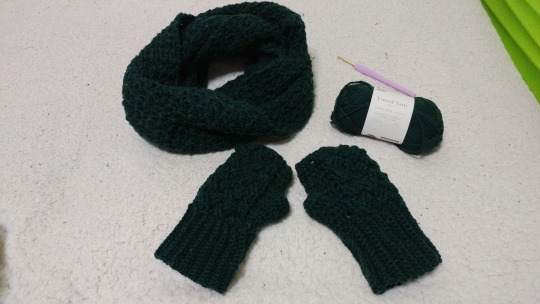
Közben egy nyugodt szerda este megszólalt a kollégiumban a tűzjelző. Kimentünk a folyosóra, és bár senki sem tudta, mi történt, lementünk a földszintre. Nem mind, voltak, akikről tudtuk, hogy itthon vannak, mégsem jöttek ki a szobájukból. A kínaiak visongtak az egyik emeleten. A jelzésre jópár perc elteltével megérkeztek a tűzoltók. Valamelyik kínai lány főzött valami felismerhetetlent és az indította be a jelzőt. A biztonság kedvéért a tűzoltók minden szobát átnéztek, leellenőrizték, hogy jól működnek-e a jelzők, aztán elmentek. Legalább fél órát fagyoskodtunk lent a közös helységben, ahol ugye nincs fűtés, felöltözni pedig nem igazán volt idő. Szerencsére senkinek nem lett baja, de aki nem jött le azonnal, mert nem akarta magára hagyni a laptopját, vagy mert nem állt jól éppen a haja, azok nem tudom mit csinálnak majd akkor, ha tényleg kigyullad valami.
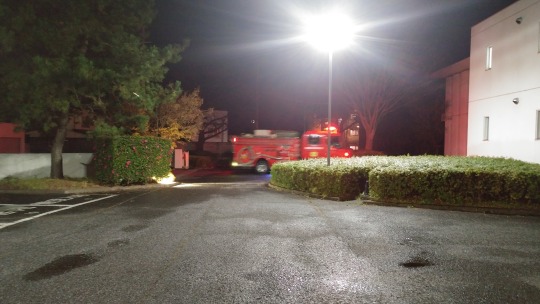
A tervezgetés közepette megvettük az első Seishun 18 Kippu nevű vonatjegyünket is, ami egy szezonális akció; évente háromszor kapható és egy hónap alatt öt napig lehet vele utazni, bármilyen elosztásban. A megkezdett napok számítanak, ezen belül annyi kilométert megyünk, amennyit csak akarunk. A jegyet csak január 10-ig lehet használni, mi pedig január 3-án érünk haza, ezért már ezen a héten elhasználtunk egyet - kicsit aggódom, hogy nehéz lesz belecsúfolni a maradék négy utat abba a kis időbe.

Elsőnek úgy döntöttünk, Aizu felé indulunk. Ahogy már írtam, Aizu a prefektúra legbelső zuga. A régió múltjában több csata és harcosokkal kapcsolatos történet is felbukkan, mi azonban a nagy aizui havazásra voltunk kíváncsiak. Ezzel a Seishun 18 Kippuvel trükkös utazni, mert a legizgalmasabb helyekre alig megy vonat, és a jegy csak a JR vállalat vonatain érvényes, amik lefednek szinte mindent, kivéve olyan kis önálló egységeket, mint Aizu, aminek saját vasútvállalata és roppant drága jegyei vannak. Ezért úgy kellett alakítanunk az utat, hogy legyen is vonat és fel is szállhassunk rá.
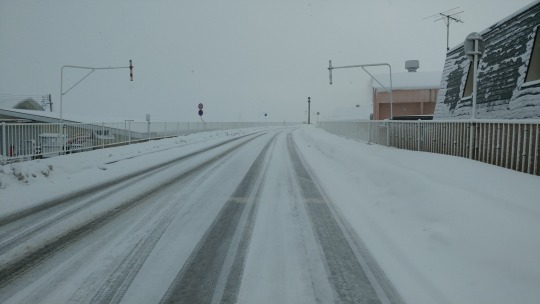
Először le kellett utazni Kooriyamáig a fél 8-as vonattal. Igazság szerint a 6:50-essel akartunk menni, de nem sikerült jól elkészülnöm reggel, így pont lekéstük. Szerencsénk volt, mert még a következővel is elértük a betervezett csatlakozást. Kooriyamából Aizu-wakamatsu felé indultunk, ami Aizu központja. Útközben azonban leszálltunk Inawashironál.
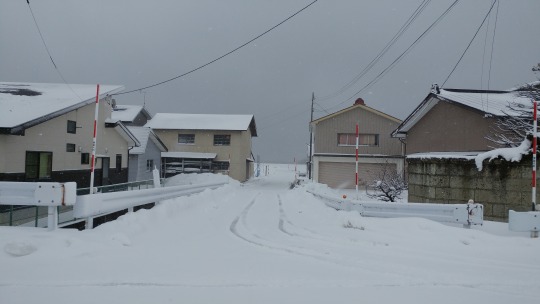
Inawashiro egy 15.000 fős kisváros az Inawashiro-tó partján, ami a 4. legnagyobb tó Japánban és telente hattyúk lepik el a partjait. A város büszkesége Noguchi Hideyo orvos és bakteriológus, aki rátalált a szifilisz kórokozójára. Mi első sorban a tavat szerettük volna látni, de már a vonaton észleltük a körülöttünk dúló hóvihart, így nem volt olyan meglepő, hogy az egész város fehér volt. A járdákon húsz centis hó, Japánban senki sem siet letakarítani a járdát, úgy tűnik, itt nem kell. Egyedül a vasút parkolója nem volt havas, de azt sem lapáttal tisztították meg, hanem az utakba beépített öntözőrendszerrel. Kis lyukakon spriccel a víz a betonra, hogy a taxik biztonságban kigördülhessenek az útra. Úgy gondoltuk, közel a tó, ezért nekivágtunk az útnak. A járda használhatatlan volt, az autókkal együtt mentünk - szerencsére kicsi volt a forgalom. A Google térképet követtük, ami hamarosan ki is vezetett minket egy kisbolthoz. A parkolóból láttuk a tó egyik szegletét, vagy húsz méterrel az orrunk előtt. Az utat viszont, ami oda vezetett, teljesen belepte a hó. Egy ideig próbáltunk elindulni, de többször térdig süllyedtem a hóban, és bizonytalan volt, hogy éppen mit találunk a lábunk alatt, mert Japánban sok vízelvezető árok van, amit, ha belep a hó, nem tudunk kikerülni. Beletörődtünk és ittunk egy meleg kakaót a kisboltban, hogy felmelegedjünk.

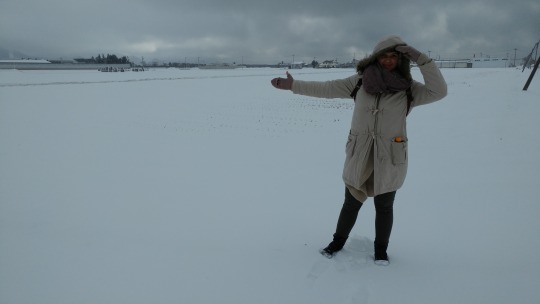


Ahogy visszafelé baktattunk valahol a semmiben, jobbra-balra rizsföldek, bekanyarodtunk egy kis útra, hogy fotózkodjunk. Zajt hallottunk; egy autó átcsúszott a szemközti sávba és felszaladt az út mentén lévő (havas) padkára. Éppen ott, ahol az előtt két perccel sétáltunk. Nyugtázva, hogy nem veszélytelen az út, tovább indultunk. vonatra szálltunk, kezünkben egy zacskó Haribo gumimacival, amit az utasellátóban vettünk. A csomagolásán az állt japánul, hogy a származási hely Magyarország. Több helyen nem álltunk meg Aizu-wakamatsuig és bár gondolkodtunk, hogy onnan tovább kéne menni valamerre, úgy döntöttünk, megnézzük, mit nyújt a város. Wakamatsuban is van turistabusz, mint amilyennel Sendaiban közlekedtünk. Váltottunk rá jegyet és elbuszoztunk a Kogaikuni szentélyig , ami a selyemkészítők és egyéb mezőgazdasági és ipari munkák védőszentélye. Bár a szentélylátogatást őszi elfoglaltságnak javasolják a vörös levelek miatt, havazásban sem olyan rossz. A torii kapuk mellett volt egy 1000 éves cseresznyefa is.


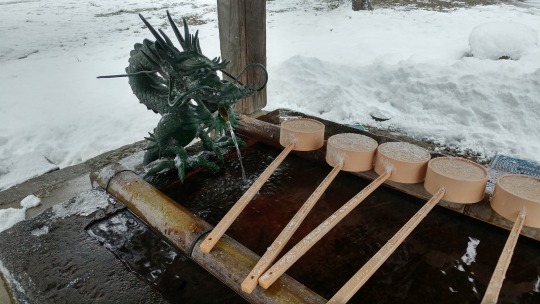

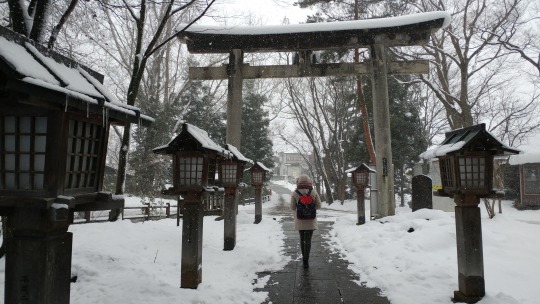
Utána a várhoz indultunk. Nehéz jól beosztani az időt, mert délután négy körül már sötétedik, és mindent világosban a legjobb megnézni – sötétedés után nagyon le is hűl a levegő. A Tsuruga-jou egy tipikus (rekonstruált) japán vár, fehér falakkal és sok emelettel. 1384-ben épült, de a használatban és a támadásokban megrendült, ezért 1874-ben lebontották, majd a legnagyobb tornyot 1965-ben újjáépítették. Ezt a tornyot jártuk körbe. A falai egészen beleolvadtak a környezetbe. Az előtte lévő parkban a fenyők ágait szorosan kikötötték a csúcsokhoz, hogy ne húzza le őket a sok hó. A vár körül vizesárok húzódik, ami helyenként már kissé befagyott.
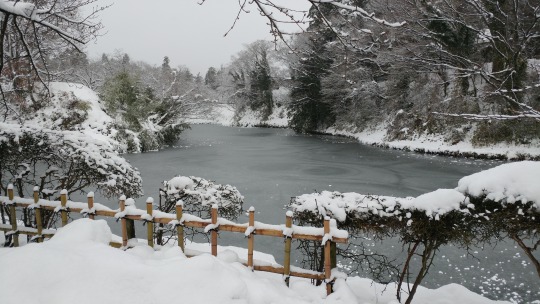
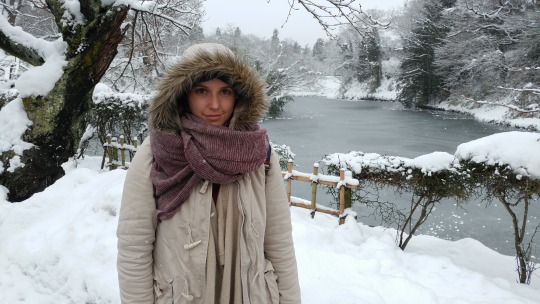
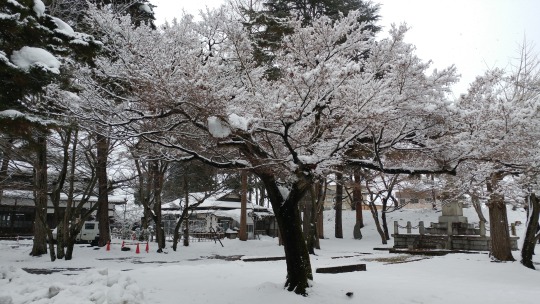
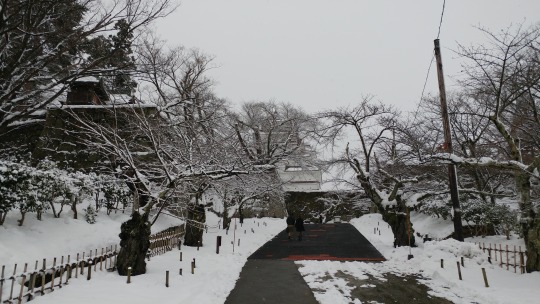
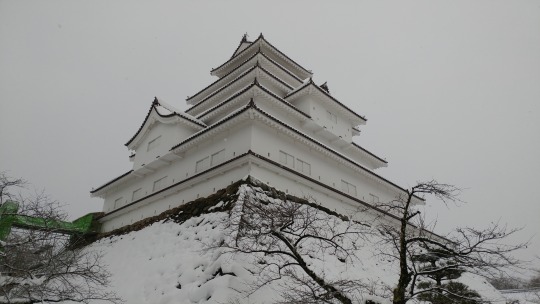
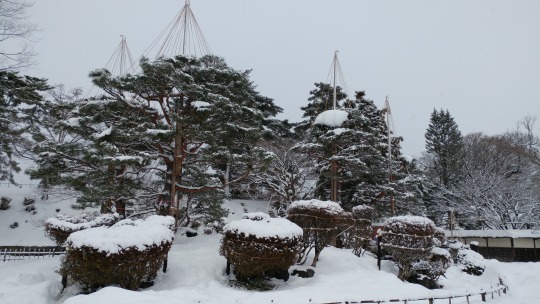

A hidegben mindig átfáztunk ezért jól esett ülni egy kicsit a meleg buszon. Bár talán nem is volt olyan hideg, mert láttunk lányokat szoknyában, harisnya nélkül. A maradék időben a város öreg negyedében sétálgattunk, ahol sok régi épület állt. A legtöbb valamilyen üzlet vagy kávézó volt, de a nagy részüket zárva találtuk. Vasárnap délután alig voltak emberek az utcán, pedig addigra már a hóesés is elállt. Az egyik utcát a már említett doktor Noguchiról nevezték el, a lámpaoszlopokat az ő arcképe díszíti.

Betértünk egy szuvenírboltba is, ahol kedvesen forró teával kínáltak minket, majd, amikor megvettük a mütyűröket, megkérdezték, hogy kitöltenénk-e egy kérdőívet. A 2020-as olimpiát Tokióban rendezik meg, így a japánok „olimpia-lázban” égnek. A tévében gyakran mutatnak felméréseket arról, hogyan várja az ország a külföldi tömegeket és a japánok gyatra angoltudása is reflektorfényben van. Ez a bolt is arról kérdezett minket, hogy mit csinálunk Aizuban, hogyan jöttünk, meddig maradunk, mi tetszett stb. A kitöltésért ajándékot is választhattunk.
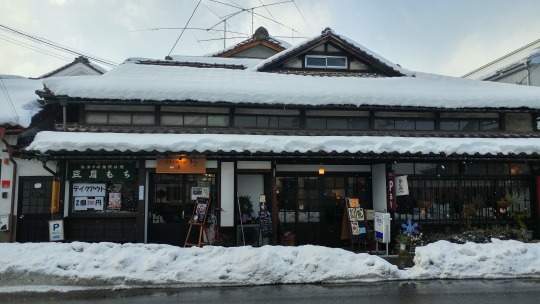
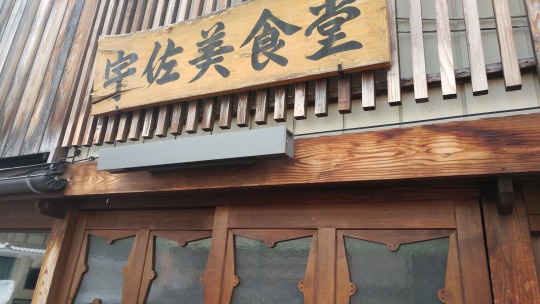
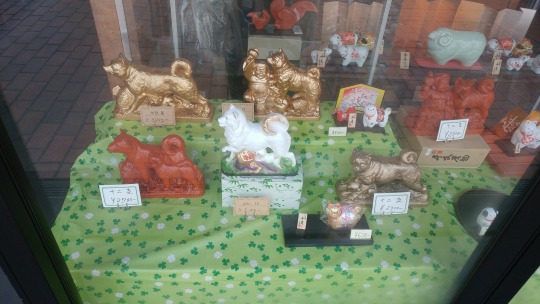
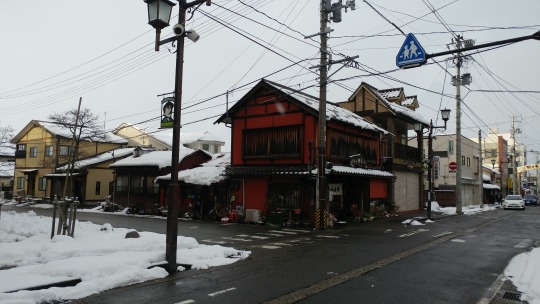
Már az állomás felé tartottunk, amikor elhaladtunk egy kis szentély mellett, ami előtt négy cica üldögélt. Talán a vacsorájukat várták, de nagyon nyugodtan szemlélték az utcát. Volt, amelyik az utolsó pillanatig a helyén maradt, nem féltek tőlünk, de megsimogatni nem tudtam őket, azt nem várták meg, mire átjutottam a hótorlaszon.


Egy meleg kávé után felszálltunk a vonatra és két órányi utazás után már itthon is voltunk. Kooriyamában nagy szerencsénk volt, mert amikor felmentünk a peronról és leolvastuk, mikor indul vonat a mi vonalunkon, már csak egy percünk volt az indulásig.

Ezzel az ötnapos bérlettel, így, hogy a vonatjegyekre nem kell költeni, nagyon olcsónak tűnik az utazás, könnyebben csábulok el egy-egy apróságra. Szerencsére ebédet készítettem itthon, így élelemben nem volt hiány, de a meleg kakaó, kávé jól esett a hidegben. Végül két apróságot vettem, mindkettőt elég olcsón: egy kitűzőt és egy… fityegőt (a japánok ezt kulcstartónak hívják, de régen, még az okostelefonok ideje előtt ezt simán telefondíszként hordták).
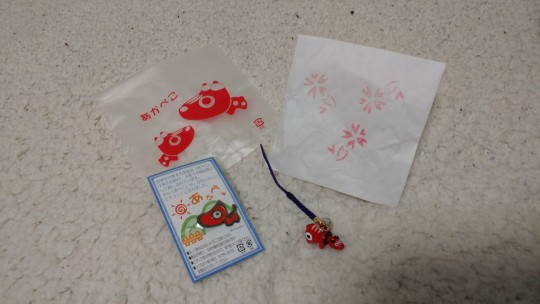
Mindkettőn ez a vörös tehénke van, akit ’akabeko’-nak hívnak (az aka azt jelenti ’vörös’, a beko pedig az aizui nyelvjárásban a ’tehén’). Az akabeko egy 16-17. századi gyerekjáték, amit a legenda szerint egy valós tehénről formáztak. Ezt a tehenet használták 807-ben, amikor az Aizu régióbeli Yanaizuban felépítették az Enzou-ji templomot. A művelettel a tehén jól járt, lelke a Buddhához távozott, a teste pedig kővé vált. Egy másik verzió szerint csak nem volt hajlandó elhagyni a templomot az építkezés végeztével, és így a buddhizmus iránti elkötelezettség jelképévé is vált. A hagyományos játék papírmaséval borított fából készül, a feje külön darab, mint a teste, így mozgatásra bólogat. Később amulettnek is tekintették, például fekete himlő ellen. A városban mindenütt szembejön ez a figura, az egyik turistabusz piros és tehenes, de a vasútállomás előtt van egy nagy, bólogató akabeko, ami gombnyomásra zenél is.

#fukushima#exchangestudentlife#aizu#akabeko#inawashiro#aizuwakamatsu#tsurugacastle#magyarblog#magyarokjapánban#留学生#ハンガリー人#会津#福島県#会津若松市#猪苗代湖#赤べこ
0 notes
Photo

Trying out this Seishun 18 kippu for the first time. Brief stop in "no mountain" because we missed our connection. Just enough time for Indian food, chu-hi, and silly photo. #seishun18kippu #japan #travel #music #musician #dharma #glutenfree #viaje #casiocore #retrofuture
0 notes